| |
Methods
Of Treatment
There are several methods by which
varicose veins can be treated. The specific procedure
or combination of procedures recommended is based
upon the severity of the condition. Some treatment
options include the following:
Laser:
In some cases, underlying vein disease
may be treated with an advanced ultrasound guided
laser technique through a single puncture or an incision
that is less than a quarter of an inch. Sometimes
referred to as endovenous laser or "endolaser",
this approach allows treatment of vein disease that
in the past required stripping through large incisions.
Our many years of experience with ultrasound guided
vein therapy makes us uniquely qualified to offer
this advanced ultrasound guided laser method to our
patients.
 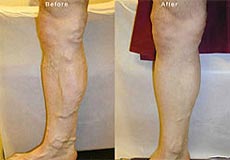
The term "LASER"
stands for Light Amplification by Stimulated Emission
of Radiation. Lasers work by producing an intense
beam of bright light that travels in one direction.
The wavelength and power output of a particular laser
determines its medical application. Laser has the
unique ability to produce one specific color (wavelength)
of light which can be varied in its intensity and
pulse duration. The laser beam can cut, seal or vaporize
skin tissue and blood vessels. Though Lasers have
been used for the treatment of skin lesions since
the 1960's, wide use of lasers for medical treatments
is a relatively recent development.
Recently, technological advances have improved lasers,
making laser surgery a preferred method of treatment
for various conditions one of which is Varicose Veins.
LASER ABLATION OF VARICOSE VEINS
| 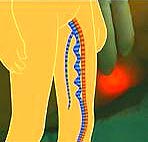
Enlarged Veins
in the Leg |
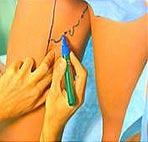
Marking Veins
in the Leg
by Ultrasound |

Local Anaesthesia
at Site |

Inserting Laser
Fibre into veins |
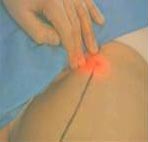
Delivering Laser
Energy |

Small Puncture
Hole at End of Case Treatment |

Before Laser Treatment
|

After Laser Treatment
|
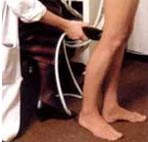 |
|
- A minimally invasive technique is applied when
treating varices of the saphenous veins with biolitec
lasers.
- The varices are located using ultrasound, and
a local anesthetic is administered to the affected
area.
- Next, the optical fiber is introduced into the
vein via a catheter and moved forward to the section
to be treated.
- In addition to the guiding beam, the fiber's correct
position is monitored by an ultrasound device.
- The laser radiation is introduced in pulse mode
and guided along the vein's lumen by slowly and
continuously retracting the fiber.
- The transformation of the laser radiation to heat
results in the thermal shrinkage and dissolution
of tissue structure, which ultimately leads to the
closure of the varicose veins by thrombosis and
spasm.
ADVANTAGES
- Due to the optimal absorption spectrum of 980
nm, the neighboring tissue areas will remain fully
intact and the veins are closed in a more gentle
fashion. 980 nm is the ideal wavelength being optimally
absorbed by water and hemoglobin. This does not
generate high levels of heat energy and therefore
does not cause tissue damage around the vein
- The closed vein remains in its natural position
in the body, which reduces the invasiveness of surgery
to a minimum.
- The incision required for this procedure is very
small and usually heals without forming a scar.
- The treatment duration of this method is relatively
short. The entire procedure takes a maximum of 45
minutes and is conducted as an out-patient procedure.
- Even the so-called reticular varices, which are
much smaller on average, can be treated successfully
through endoluminal laser therapy.
- Lasers can also be used in the external "non-contact"
treatment of superficial veins. In this procedure,
telengiectasia and the finest spider veins are made
invisible by passing the 980 nm laser light with
a special applicator over the skin.
- The fine vessels are obliterated quickly and gently
by coagulation and vaporization of blood contained
within them.
- Reduced risk of infection
- Improved therapeutic results
SIDE EFFECTS
The LASER ABLATION method is well
tolerated and has few side effects. A large proportion
of the patients treated in this way are able to resume
their normal activities immediately following surgery.
Some patients may experience a slight ache along the
shrunken veins, for which local cooling and an anti-inflammatory
ointment will provide quick and reliable relief. Very
rarely is there hematoma formation.
In addition to the treatment of
small teleangiectasia and spider veins, the laser
is also suited for the treatment of varices caused
by incompetence of the long and short saphenous veins,
as well as acting upon the lateral and reticular veins.
Compared to conventional vein therapy
such as the so-called "stripping" procedure,
the Laser Ablation technique has a combination of
advantages: it is minimally invasive and therefore
a less traumatic procedure with optimal cosmetic effect
and excellent and extremely promising results: the
patient walks in for the treatment and walks out with
his/her varices problems solved within one hour!
|